Early Launch of System: Ethics Analysis - Charles Sturt University
VerifiedAdded on 2020/03/04
|6
|2313
|217
Homework Assignment
AI Summary
This assignment analyzes an ethical dilemma concerning the early launch of a software system. The scenario involves a project director pressuring a project manager to release software before its encryption is fully completed, potentially compromising its security. The analysis, using the Doing Ethics Technique, identifies the facts, non-ethical issues (technical vulnerabilities), stakeholders (project team, client, end-users, and cybercriminals), and ethical issues (pressuring subordinates, security vulnerabilities, and exploitation of information). The assignment explores the implications of these issues, including potential data breaches and reputational damage. It evaluates various options, such as adhering to the original schedule and informing the CEO of the risks, ultimately suggesting the best course of action is to inform the client organization regarding the security concerns and ask for more time to complete the project. The paper emphasizes the importance of ethical decision-making in IT project management, and the assignment is referenced with citations.
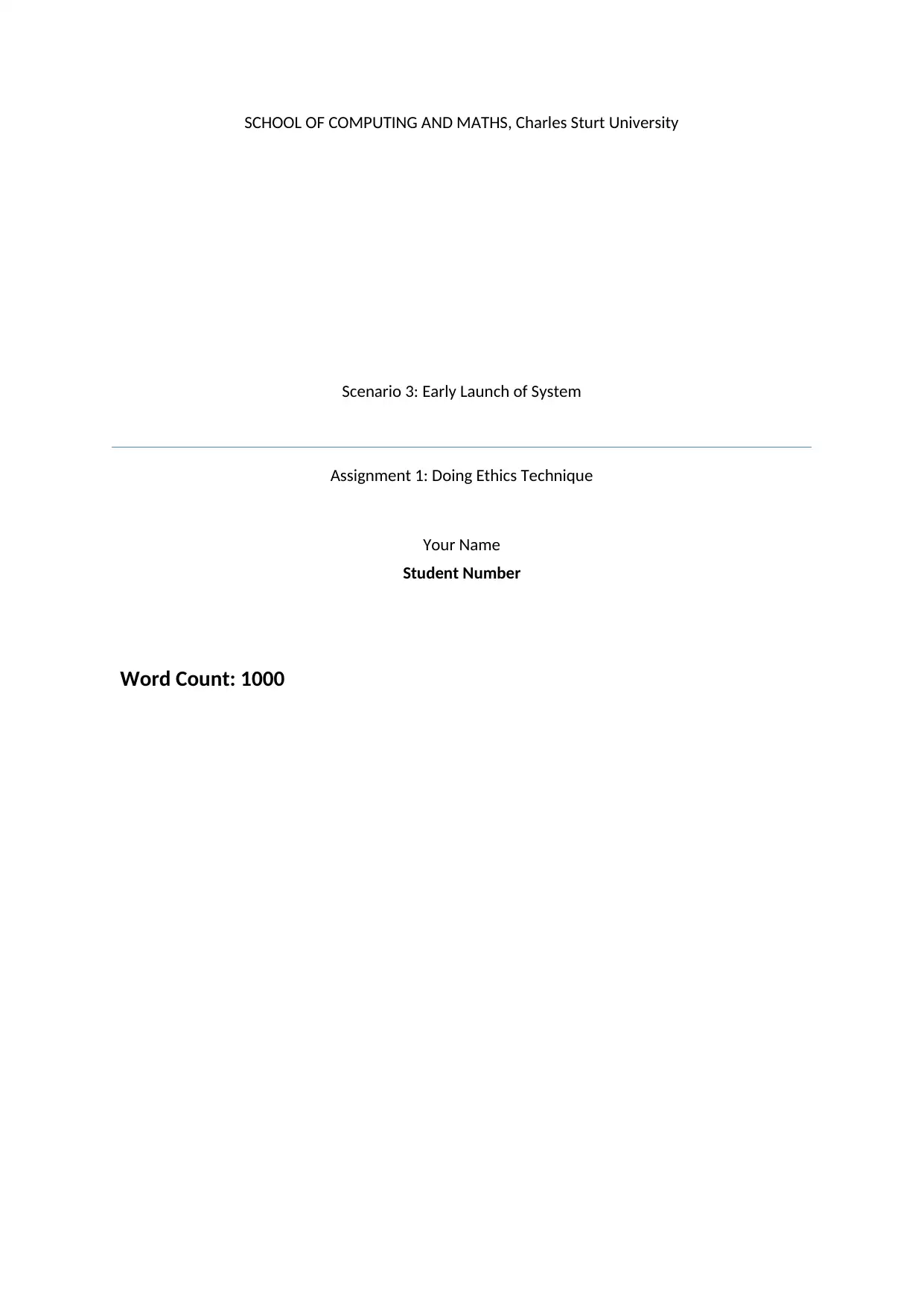
SCHOOL OF COMPUTING AND MATHS, Charles Sturt University
Scenario 3: Early Launch of System
Assignment 1: Doing Ethics Technique
Your Name
Student Number
Word Count: 1000
Scenario 3: Early Launch of System
Assignment 1: Doing Ethics Technique
Your Name
Student Number
Word Count: 1000
Paraphrase This Document
Need a fresh take? Get an instant paraphrase of this document with our AI Paraphraser
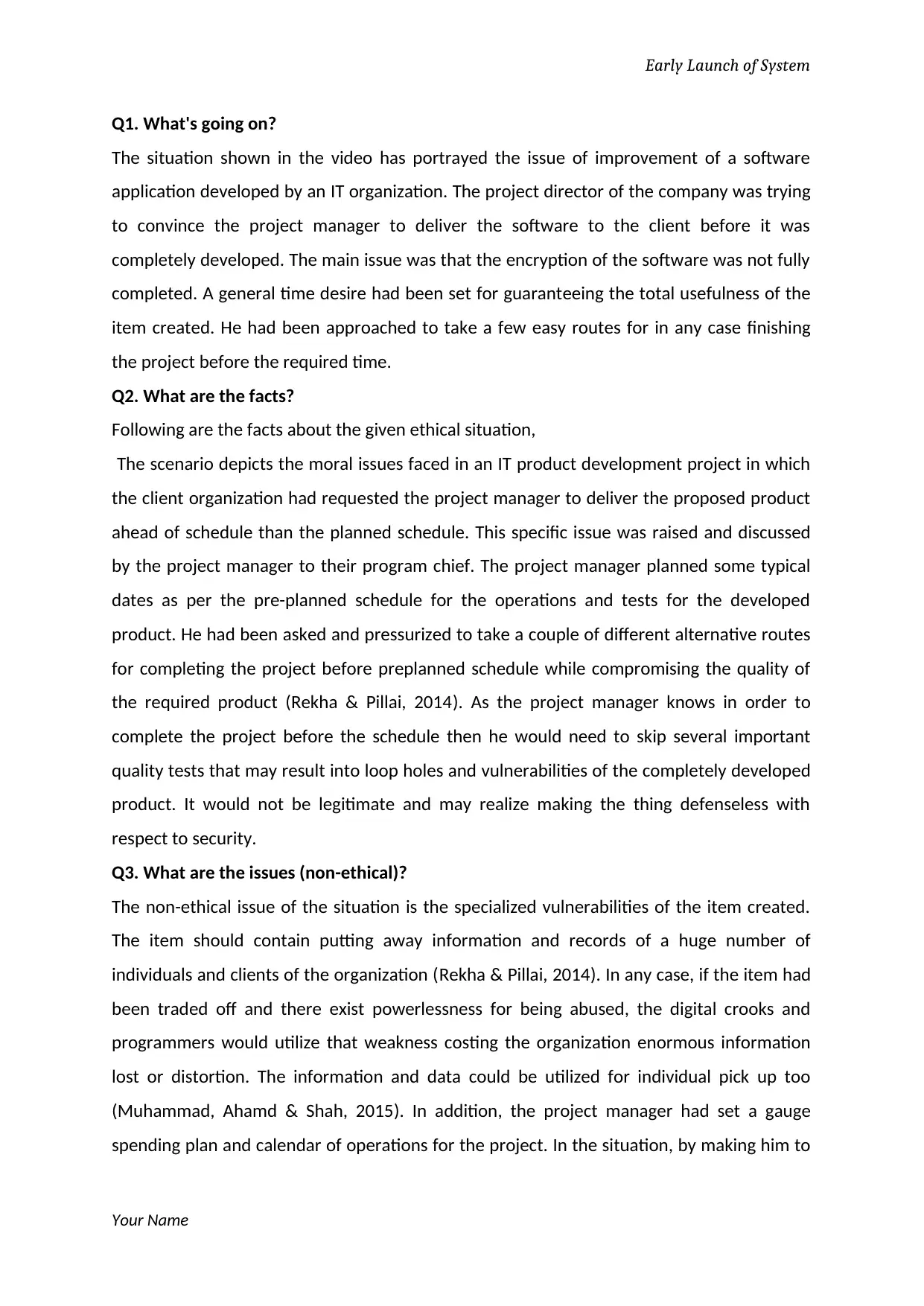
Early Launch of System
Q1. What's going on?
The situation shown in the video has portrayed the issue of improvement of a software
application developed by an IT organization. The project director of the company was trying
to convince the project manager to deliver the software to the client before it was
completely developed. The main issue was that the encryption of the software was not fully
completed. A general time desire had been set for guaranteeing the total usefulness of the
item created. He had been approached to take a few easy routes for in any case finishing
the project before the required time.
Q2. What are the facts?
Following are the facts about the given ethical situation,
The scenario depicts the moral issues faced in an IT product development project in which
the client organization had requested the project manager to deliver the proposed product
ahead of schedule than the planned schedule. This specific issue was raised and discussed
by the project manager to their program chief. The project manager planned some typical
dates as per the pre-planned schedule for the operations and tests for the developed
product. He had been asked and pressurized to take a couple of different alternative routes
for completing the project before preplanned schedule while compromising the quality of
the required product (Rekha & Pillai, 2014). As the project manager knows in order to
complete the project before the schedule then he would need to skip several important
quality tests that may result into loop holes and vulnerabilities of the completely developed
product. It would not be legitimate and may realize making the thing defenseless with
respect to security.
Q3. What are the issues (non-ethical)?
The non-ethical issue of the situation is the specialized vulnerabilities of the item created.
The item should contain putting away information and records of a huge number of
individuals and clients of the organization (Rekha & Pillai, 2014). In any case, if the item had
been traded off and there exist powerlessness for being abused, the digital crooks and
programmers would utilize that weakness costing the organization enormous information
lost or distortion. The information and data could be utilized for individual pick up too
(Muhammad, Ahamd & Shah, 2015). In addition, the project manager had set a gauge
spending plan and calendar of operations for the project. In the situation, by making him to
Your Name
Q1. What's going on?
The situation shown in the video has portrayed the issue of improvement of a software
application developed by an IT organization. The project director of the company was trying
to convince the project manager to deliver the software to the client before it was
completely developed. The main issue was that the encryption of the software was not fully
completed. A general time desire had been set for guaranteeing the total usefulness of the
item created. He had been approached to take a few easy routes for in any case finishing
the project before the required time.
Q2. What are the facts?
Following are the facts about the given ethical situation,
The scenario depicts the moral issues faced in an IT product development project in which
the client organization had requested the project manager to deliver the proposed product
ahead of schedule than the planned schedule. This specific issue was raised and discussed
by the project manager to their program chief. The project manager planned some typical
dates as per the pre-planned schedule for the operations and tests for the developed
product. He had been asked and pressurized to take a couple of different alternative routes
for completing the project before preplanned schedule while compromising the quality of
the required product (Rekha & Pillai, 2014). As the project manager knows in order to
complete the project before the schedule then he would need to skip several important
quality tests that may result into loop holes and vulnerabilities of the completely developed
product. It would not be legitimate and may realize making the thing defenseless with
respect to security.
Q3. What are the issues (non-ethical)?
The non-ethical issue of the situation is the specialized vulnerabilities of the item created.
The item should contain putting away information and records of a huge number of
individuals and clients of the organization (Rekha & Pillai, 2014). In any case, if the item had
been traded off and there exist powerlessness for being abused, the digital crooks and
programmers would utilize that weakness costing the organization enormous information
lost or distortion. The information and data could be utilized for individual pick up too
(Muhammad, Ahamd & Shah, 2015). In addition, the project manager had set a gauge
spending plan and calendar of operations for the project. In the situation, by making him to
Your Name

Early Launch of System
convey the project early, the project would be very harmful for both the user organization
and the developer organization.
Q4. Who is affected?
The engaged project team for this project and the client organization for this project would
have to confront immense commitments in case the developed product developed by them
(project team) would not be proper and meting the customer's prerequisites set for
product. The organization would need to confront the outcomes and lose their market
reputation because of the security vulnerabilities of the developed item by them
(Muhammad, Ahamd & Shah, 2015). The customer of the client organization whose
personal and financial data may get exposed due to the vulnerabilities would be equally
influenced by the multiple issues in this situation of ethical issues. The confidential and
sensitive information of the user of the system would be liked out, which is very harmful
both the client and developer organization. The main individual who might be profited from
this problematic situation would be the hackers or the cyber criminals who may hack into
the system for abusing the information and data of the customers of the client organization.
Q5. What are the ethical issues and their implications?
The given situation for the client organization demonstrates the moral dilemma of an IT
anticipate in which the customer had requested that the project manager to deliver an item
(end result of the project) at his mentioned time rather than what had been planned for the
project. The project manager had been requested by the client organization in order to take
alternate routes/paths for the completion of the project before the planned time for which
the project manager would need to fast track the project and skip several important tests
and take numerous easy routes and it may bring down the quality of the product and the
item defenseless as far as security concerns for which it is intended to be used by the client
organization. Another issues is related to the pressurizing their subordinates for conflicting
with his/her will in order to complete the project. The exploitation of the available
information because of the security helplessness is another ethical issue in the give
scenario. The information and data of a large number of the general population would get
exposed due to the weakness of the product and would be abused by the cyber criminals.
Q6. What can be done about it?
The situation had demonstrated the moral issue of pressurizing your subordinates for
conflicting with his/her will and the security weakness of an IT item where the information
Your Name
convey the project early, the project would be very harmful for both the user organization
and the developer organization.
Q4. Who is affected?
The engaged project team for this project and the client organization for this project would
have to confront immense commitments in case the developed product developed by them
(project team) would not be proper and meting the customer's prerequisites set for
product. The organization would need to confront the outcomes and lose their market
reputation because of the security vulnerabilities of the developed item by them
(Muhammad, Ahamd & Shah, 2015). The customer of the client organization whose
personal and financial data may get exposed due to the vulnerabilities would be equally
influenced by the multiple issues in this situation of ethical issues. The confidential and
sensitive information of the user of the system would be liked out, which is very harmful
both the client and developer organization. The main individual who might be profited from
this problematic situation would be the hackers or the cyber criminals who may hack into
the system for abusing the information and data of the customers of the client organization.
Q5. What are the ethical issues and their implications?
The given situation for the client organization demonstrates the moral dilemma of an IT
anticipate in which the customer had requested that the project manager to deliver an item
(end result of the project) at his mentioned time rather than what had been planned for the
project. The project manager had been requested by the client organization in order to take
alternate routes/paths for the completion of the project before the planned time for which
the project manager would need to fast track the project and skip several important tests
and take numerous easy routes and it may bring down the quality of the product and the
item defenseless as far as security concerns for which it is intended to be used by the client
organization. Another issues is related to the pressurizing their subordinates for conflicting
with his/her will in order to complete the project. The exploitation of the available
information because of the security helplessness is another ethical issue in the give
scenario. The information and data of a large number of the general population would get
exposed due to the weakness of the product and would be abused by the cyber criminals.
Q6. What can be done about it?
The situation had demonstrated the moral issue of pressurizing your subordinates for
conflicting with his/her will and the security weakness of an IT item where the information
Your Name
⊘ This is a preview!⊘
Do you want full access?
Subscribe today to unlock all pages.

Trusted by 1+ million students worldwide
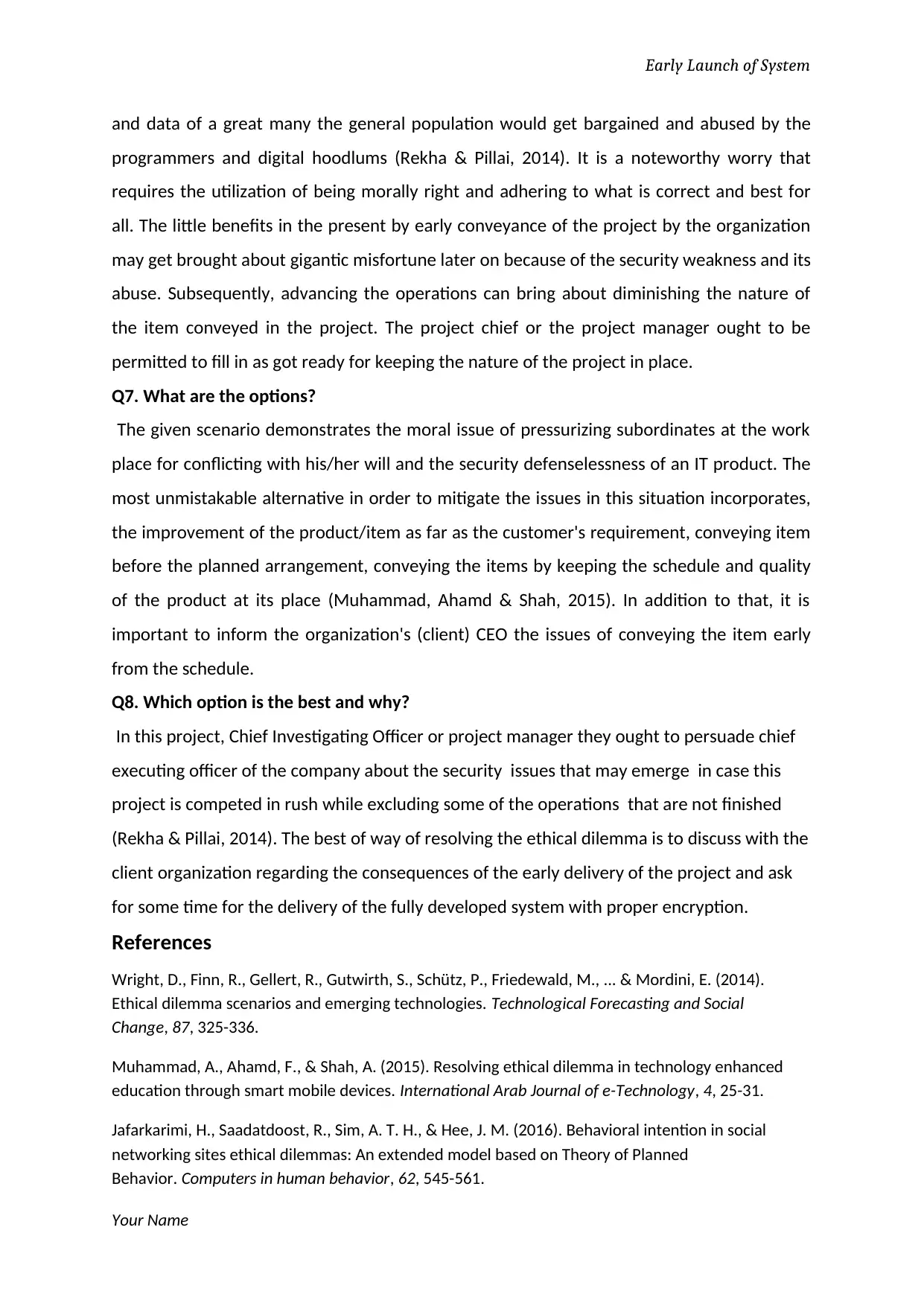
Early Launch of System
and data of a great many the general population would get bargained and abused by the
programmers and digital hoodlums (Rekha & Pillai, 2014). It is a noteworthy worry that
requires the utilization of being morally right and adhering to what is correct and best for
all. The little benefits in the present by early conveyance of the project by the organization
may get brought about gigantic misfortune later on because of the security weakness and its
abuse. Subsequently, advancing the operations can bring about diminishing the nature of
the item conveyed in the project. The project chief or the project manager ought to be
permitted to fill in as got ready for keeping the nature of the project in place.
Q7. What are the options?
The given scenario demonstrates the moral issue of pressurizing subordinates at the work
place for conflicting with his/her will and the security defenselessness of an IT product. The
most unmistakable alternative in order to mitigate the issues in this situation incorporates,
the improvement of the product/item as far as the customer's requirement, conveying item
before the planned arrangement, conveying the items by keeping the schedule and quality
of the product at its place (Muhammad, Ahamd & Shah, 2015). In addition to that, it is
important to inform the organization's (client) CEO the issues of conveying the item early
from the schedule.
Q8. Which option is the best and why?
In this project, Chief Investigating Officer or project manager they ought to persuade chief
executing officer of the company about the security issues that may emerge in case this
project is competed in rush while excluding some of the operations that are not finished
(Rekha & Pillai, 2014). The best of way of resolving the ethical dilemma is to discuss with the
client organization regarding the consequences of the early delivery of the project and ask
for some time for the delivery of the fully developed system with proper encryption.
References
Wright, D., Finn, R., Gellert, R., Gutwirth, S., Schütz, P., Friedewald, M., ... & Mordini, E. (2014).
Ethical dilemma scenarios and emerging technologies. Technological Forecasting and Social
Change, 87, 325-336.
Muhammad, A., Ahamd, F., & Shah, A. (2015). Resolving ethical dilemma in technology enhanced
education through smart mobile devices. International Arab Journal of e-Technology, 4, 25-31.
Jafarkarimi, H., Saadatdoost, R., Sim, A. T. H., & Hee, J. M. (2016). Behavioral intention in social
networking sites ethical dilemmas: An extended model based on Theory of Planned
Behavior. Computers in human behavior, 62, 545-561.
Your Name
and data of a great many the general population would get bargained and abused by the
programmers and digital hoodlums (Rekha & Pillai, 2014). It is a noteworthy worry that
requires the utilization of being morally right and adhering to what is correct and best for
all. The little benefits in the present by early conveyance of the project by the organization
may get brought about gigantic misfortune later on because of the security weakness and its
abuse. Subsequently, advancing the operations can bring about diminishing the nature of
the item conveyed in the project. The project chief or the project manager ought to be
permitted to fill in as got ready for keeping the nature of the project in place.
Q7. What are the options?
The given scenario demonstrates the moral issue of pressurizing subordinates at the work
place for conflicting with his/her will and the security defenselessness of an IT product. The
most unmistakable alternative in order to mitigate the issues in this situation incorporates,
the improvement of the product/item as far as the customer's requirement, conveying item
before the planned arrangement, conveying the items by keeping the schedule and quality
of the product at its place (Muhammad, Ahamd & Shah, 2015). In addition to that, it is
important to inform the organization's (client) CEO the issues of conveying the item early
from the schedule.
Q8. Which option is the best and why?
In this project, Chief Investigating Officer or project manager they ought to persuade chief
executing officer of the company about the security issues that may emerge in case this
project is competed in rush while excluding some of the operations that are not finished
(Rekha & Pillai, 2014). The best of way of resolving the ethical dilemma is to discuss with the
client organization regarding the consequences of the early delivery of the project and ask
for some time for the delivery of the fully developed system with proper encryption.
References
Wright, D., Finn, R., Gellert, R., Gutwirth, S., Schütz, P., Friedewald, M., ... & Mordini, E. (2014).
Ethical dilemma scenarios and emerging technologies. Technological Forecasting and Social
Change, 87, 325-336.
Muhammad, A., Ahamd, F., & Shah, A. (2015). Resolving ethical dilemma in technology enhanced
education through smart mobile devices. International Arab Journal of e-Technology, 4, 25-31.
Jafarkarimi, H., Saadatdoost, R., Sim, A. T. H., & Hee, J. M. (2016). Behavioral intention in social
networking sites ethical dilemmas: An extended model based on Theory of Planned
Behavior. Computers in human behavior, 62, 545-561.
Your Name
Paraphrase This Document
Need a fresh take? Get an instant paraphrase of this document with our AI Paraphraser
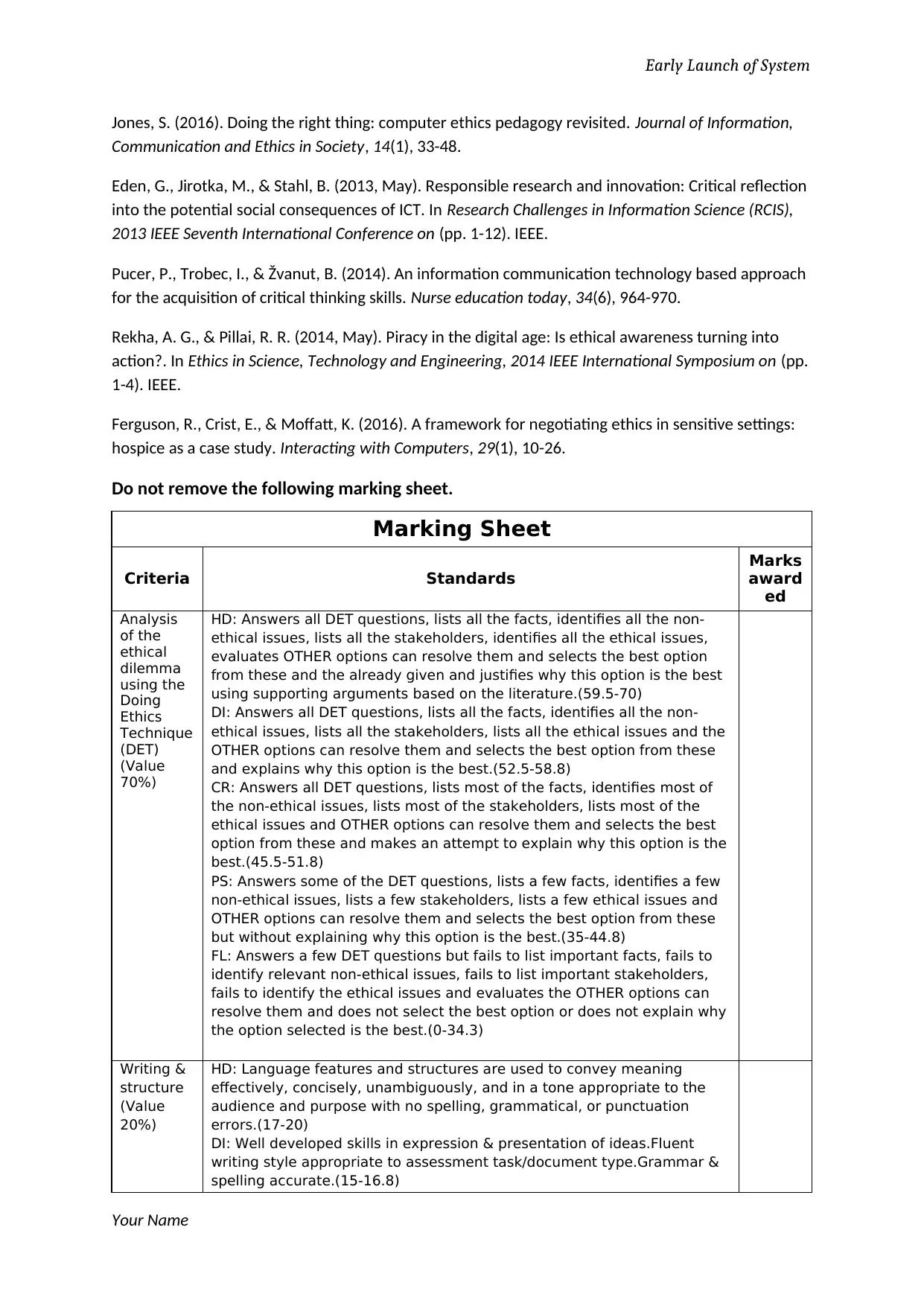
Early Launch of System
Jones, S. (2016). Doing the right thing: computer ethics pedagogy revisited. Journal of Information,
Communication and Ethics in Society, 14(1), 33-48.
Eden, G., Jirotka, M., & Stahl, B. (2013, May). Responsible research and innovation: Critical reflection
into the potential social consequences of ICT. In Research Challenges in Information Science (RCIS),
2013 IEEE Seventh International Conference on (pp. 1-12). IEEE.
Pucer, P., Trobec, I., & Žvanut, B. (2014). An information communication technology based approach
for the acquisition of critical thinking skills. Nurse education today, 34(6), 964-970.
Rekha, A. G., & Pillai, R. R. (2014, May). Piracy in the digital age: Is ethical awareness turning into
action?. In Ethics in Science, Technology and Engineering, 2014 IEEE International Symposium on (pp.
1-4). IEEE.
Ferguson, R., Crist, E., & Moffatt, K. (2016). A framework for negotiating ethics in sensitive settings:
hospice as a case study. Interacting with Computers, 29(1), 10-26.
Do not remove the following marking sheet.
Marking Sheet
Criteria Standards
Marks
award
ed
Analysis
of the
ethical
dilemma
using the
Doing
Ethics
Technique
(DET)
(Value
70%)
HD: Answers all DET questions, lists all the facts, identifies all the non-
ethical issues, lists all the stakeholders, identifies all the ethical issues,
evaluates OTHER options can resolve them and selects the best option
from these and the already given and justifies why this option is the best
using supporting arguments based on the literature.(59.5-70)
DI: Answers all DET questions, lists all the facts, identifies all the non-
ethical issues, lists all the stakeholders, lists all the ethical issues and the
OTHER options can resolve them and selects the best option from these
and explains why this option is the best.(52.5-58.8)
CR: Answers all DET questions, lists most of the facts, identifies most of
the non-ethical issues, lists most of the stakeholders, lists most of the
ethical issues and OTHER options can resolve them and selects the best
option from these and makes an attempt to explain why this option is the
best.(45.5-51.8)
PS: Answers some of the DET questions, lists a few facts, identifies a few
non-ethical issues, lists a few stakeholders, lists a few ethical issues and
OTHER options can resolve them and selects the best option from these
but without explaining why this option is the best.(35-44.8)
FL: Answers a few DET questions but fails to list important facts, fails to
identify relevant non-ethical issues, fails to list important stakeholders,
fails to identify the ethical issues and evaluates the OTHER options can
resolve them and does not select the best option or does not explain why
the option selected is the best.(0-34.3)
Writing &
structure
(Value
20%)
HD: Language features and structures are used to convey meaning
effectively, concisely, unambiguously, and in a tone appropriate to the
audience and purpose with no spelling, grammatical, or punctuation
errors.(17-20)
DI: Well developed skills in expression & presentation of ideas.Fluent
writing style appropriate to assessment task/document type.Grammar &
spelling accurate.(15-16.8)
Your Name
Jones, S. (2016). Doing the right thing: computer ethics pedagogy revisited. Journal of Information,
Communication and Ethics in Society, 14(1), 33-48.
Eden, G., Jirotka, M., & Stahl, B. (2013, May). Responsible research and innovation: Critical reflection
into the potential social consequences of ICT. In Research Challenges in Information Science (RCIS),
2013 IEEE Seventh International Conference on (pp. 1-12). IEEE.
Pucer, P., Trobec, I., & Žvanut, B. (2014). An information communication technology based approach
for the acquisition of critical thinking skills. Nurse education today, 34(6), 964-970.
Rekha, A. G., & Pillai, R. R. (2014, May). Piracy in the digital age: Is ethical awareness turning into
action?. In Ethics in Science, Technology and Engineering, 2014 IEEE International Symposium on (pp.
1-4). IEEE.
Ferguson, R., Crist, E., & Moffatt, K. (2016). A framework for negotiating ethics in sensitive settings:
hospice as a case study. Interacting with Computers, 29(1), 10-26.
Do not remove the following marking sheet.
Marking Sheet
Criteria Standards
Marks
award
ed
Analysis
of the
ethical
dilemma
using the
Doing
Ethics
Technique
(DET)
(Value
70%)
HD: Answers all DET questions, lists all the facts, identifies all the non-
ethical issues, lists all the stakeholders, identifies all the ethical issues,
evaluates OTHER options can resolve them and selects the best option
from these and the already given and justifies why this option is the best
using supporting arguments based on the literature.(59.5-70)
DI: Answers all DET questions, lists all the facts, identifies all the non-
ethical issues, lists all the stakeholders, lists all the ethical issues and the
OTHER options can resolve them and selects the best option from these
and explains why this option is the best.(52.5-58.8)
CR: Answers all DET questions, lists most of the facts, identifies most of
the non-ethical issues, lists most of the stakeholders, lists most of the
ethical issues and OTHER options can resolve them and selects the best
option from these and makes an attempt to explain why this option is the
best.(45.5-51.8)
PS: Answers some of the DET questions, lists a few facts, identifies a few
non-ethical issues, lists a few stakeholders, lists a few ethical issues and
OTHER options can resolve them and selects the best option from these
but without explaining why this option is the best.(35-44.8)
FL: Answers a few DET questions but fails to list important facts, fails to
identify relevant non-ethical issues, fails to list important stakeholders,
fails to identify the ethical issues and evaluates the OTHER options can
resolve them and does not select the best option or does not explain why
the option selected is the best.(0-34.3)
Writing &
structure
(Value
20%)
HD: Language features and structures are used to convey meaning
effectively, concisely, unambiguously, and in a tone appropriate to the
audience and purpose with no spelling, grammatical, or punctuation
errors.(17-20)
DI: Well developed skills in expression & presentation of ideas.Fluent
writing style appropriate to assessment task/document type.Grammar &
spelling accurate.(15-16.8)
Your Name
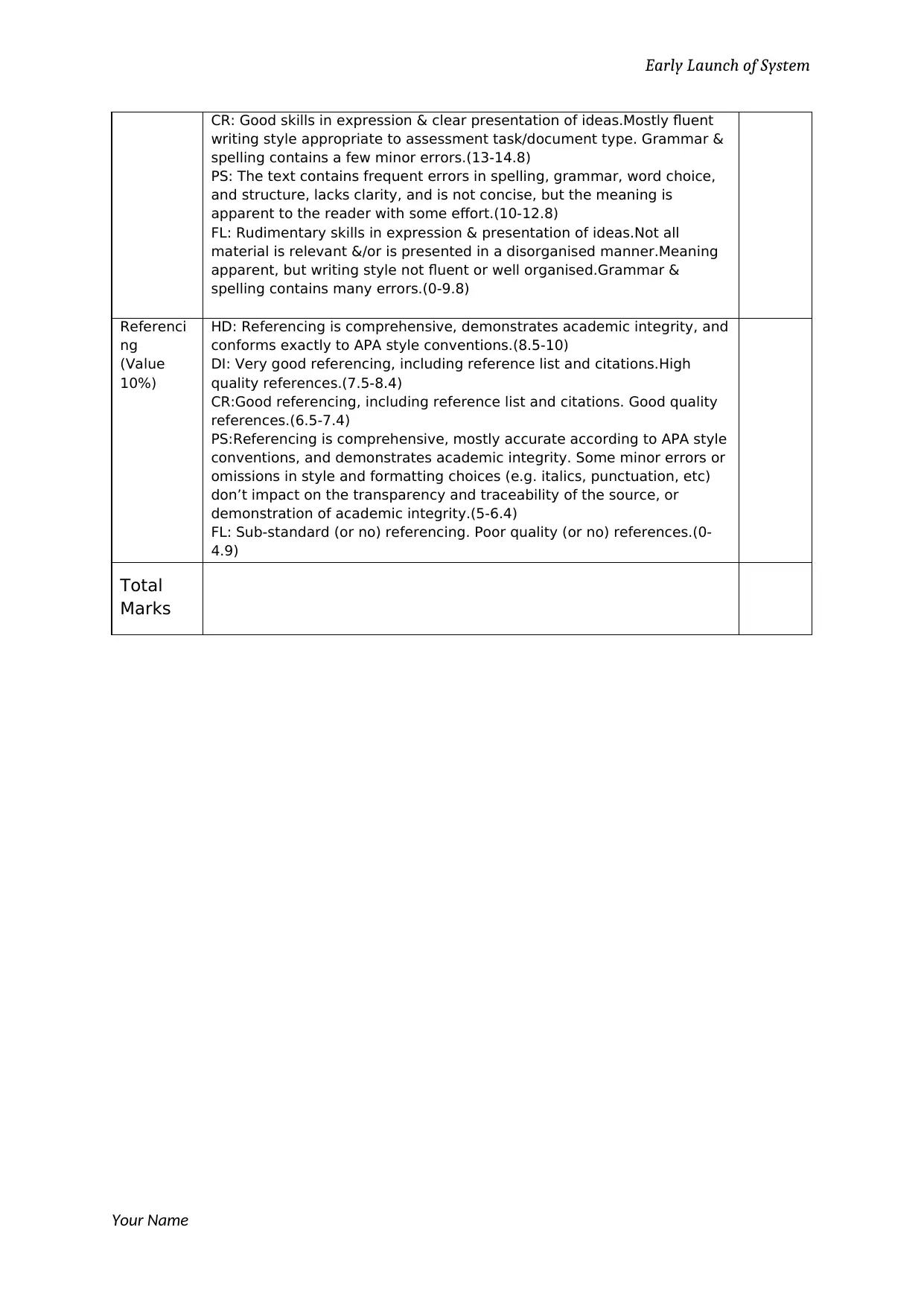
Early Launch of System
CR: Good skills in expression & clear presentation of ideas.Mostly fluent
writing style appropriate to assessment task/document type. Grammar &
spelling contains a few minor errors.(13-14.8)
PS: The text contains frequent errors in spelling, grammar, word choice,
and structure, lacks clarity, and is not concise, but the meaning is
apparent to the reader with some effort.(10-12.8)
FL: Rudimentary skills in expression & presentation of ideas.Not all
material is relevant &/or is presented in a disorganised manner.Meaning
apparent, but writing style not fluent or well organised.Grammar &
spelling contains many errors.(0-9.8)
Referenci
ng
(Value
10%)
HD: Referencing is comprehensive, demonstrates academic integrity, and
conforms exactly to APA style conventions.(8.5-10)
DI: Very good referencing, including reference list and citations.High
quality references.(7.5-8.4)
CR:Good referencing, including reference list and citations. Good quality
references.(6.5-7.4)
PS:Referencing is comprehensive, mostly accurate according to APA style
conventions, and demonstrates academic integrity. Some minor errors or
omissions in style and formatting choices (e.g. italics, punctuation, etc)
don’t impact on the transparency and traceability of the source, or
demonstration of academic integrity.(5-6.4)
FL: Sub-standard (or no) referencing. Poor quality (or no) references.(0-
4.9)
Total
Marks
Your Name
CR: Good skills in expression & clear presentation of ideas.Mostly fluent
writing style appropriate to assessment task/document type. Grammar &
spelling contains a few minor errors.(13-14.8)
PS: The text contains frequent errors in spelling, grammar, word choice,
and structure, lacks clarity, and is not concise, but the meaning is
apparent to the reader with some effort.(10-12.8)
FL: Rudimentary skills in expression & presentation of ideas.Not all
material is relevant &/or is presented in a disorganised manner.Meaning
apparent, but writing style not fluent or well organised.Grammar &
spelling contains many errors.(0-9.8)
Referenci
ng
(Value
10%)
HD: Referencing is comprehensive, demonstrates academic integrity, and
conforms exactly to APA style conventions.(8.5-10)
DI: Very good referencing, including reference list and citations.High
quality references.(7.5-8.4)
CR:Good referencing, including reference list and citations. Good quality
references.(6.5-7.4)
PS:Referencing is comprehensive, mostly accurate according to APA style
conventions, and demonstrates academic integrity. Some minor errors or
omissions in style and formatting choices (e.g. italics, punctuation, etc)
don’t impact on the transparency and traceability of the source, or
demonstration of academic integrity.(5-6.4)
FL: Sub-standard (or no) referencing. Poor quality (or no) references.(0-
4.9)
Total
Marks
Your Name
⊘ This is a preview!⊘
Do you want full access?
Subscribe today to unlock all pages.

Trusted by 1+ million students worldwide
1 out of 6
Related Documents
Your All-in-One AI-Powered Toolkit for Academic Success.
+13062052269
info@desklib.com
Available 24*7 on WhatsApp / Email
![[object Object]](/_next/static/media/star-bottom.7253800d.svg)
Unlock your academic potential
Copyright © 2020–2025 A2Z Services. All Rights Reserved. Developed and managed by ZUCOL.




